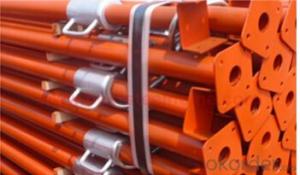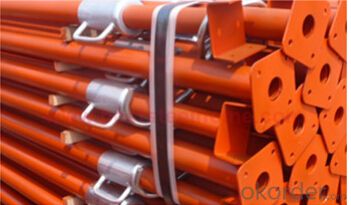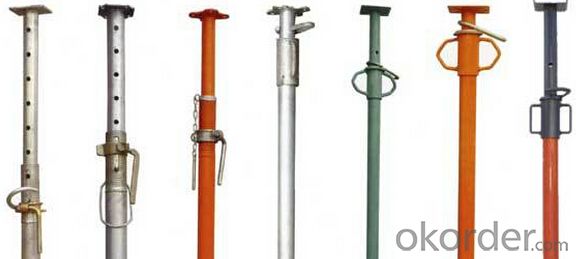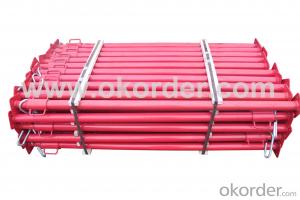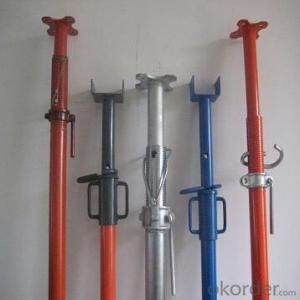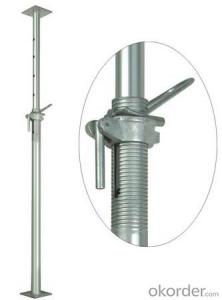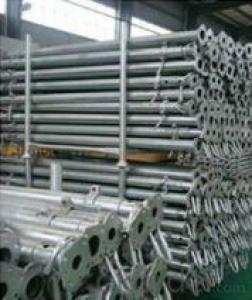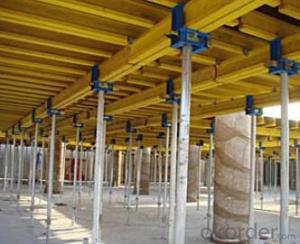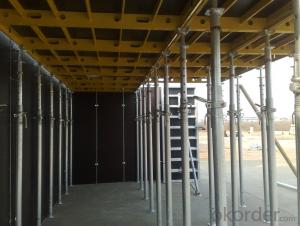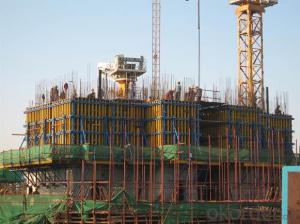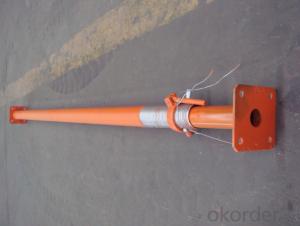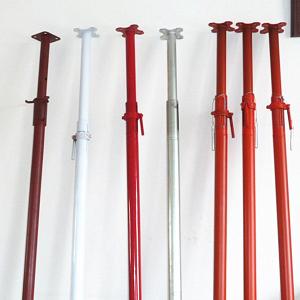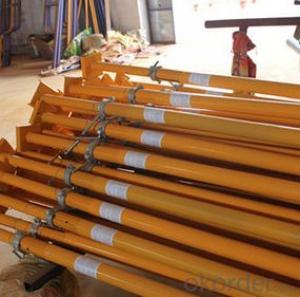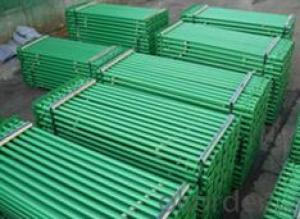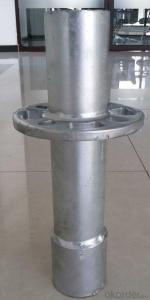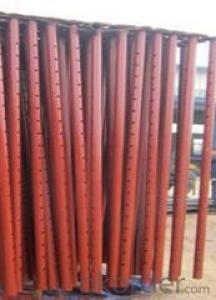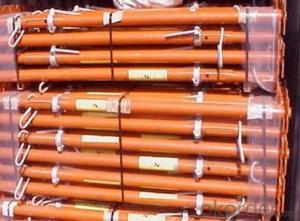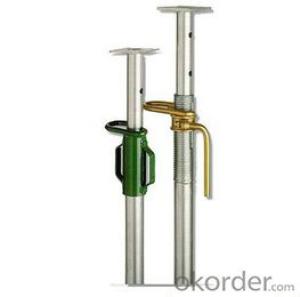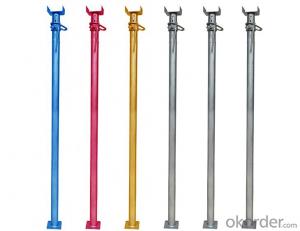Scaffolding Steel Props / Shoring Props for Scaffolding System
- Loading Port:
- China main port
- Payment Terms:
- TT OR LC
- Min Order Qty:
- 1000 pc
- Supply Capability:
- 1000000 pc/month
OKorder Service Pledge
OKorder Financial Service
You Might Also Like
Product information:
Model Number: GTJ-P003
Name: Q235 High Quality Steel Slab Props
Material: Q235
Thickness: 1.6mm to3mm or as your requirements
Surface Treatment: as per requirements
Standard: use your standard or international standard
Dimension: Light duty 40-48mm, MID Duty 48-56/58mm, Heavy duty 48-60mm
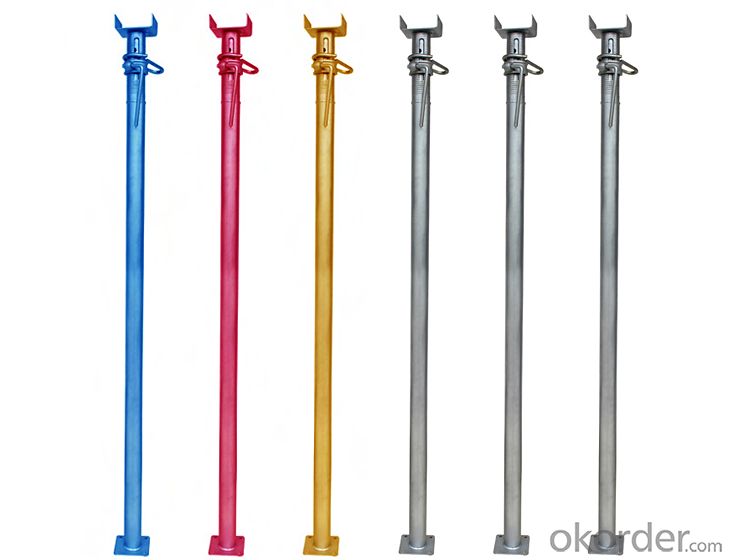
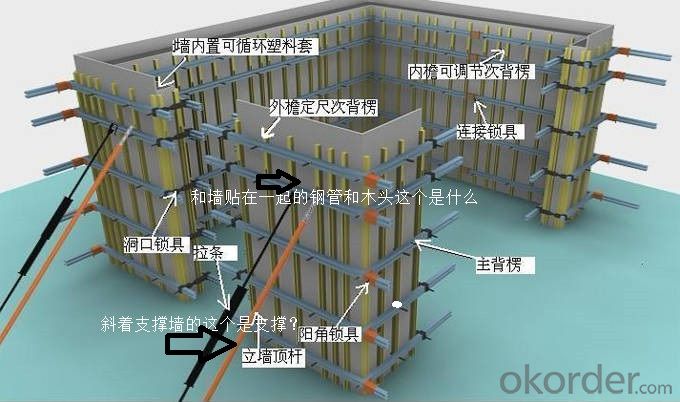
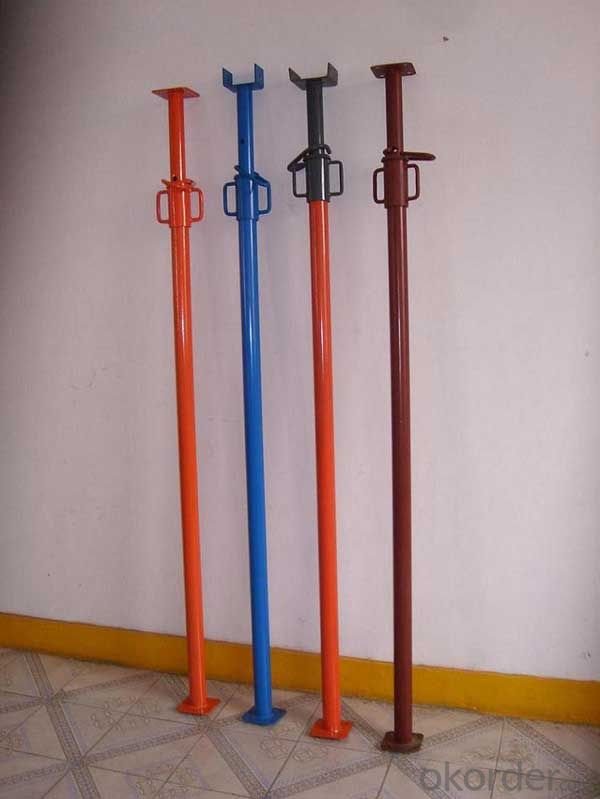
Characteristics:
1. Reliable performance
2. Corrosion resistance
3. Durable finish standards
Functions
It is used for construction supporting, timber, formwork, concrete slab and so on. It is very easy and reliable to use
Why Choose Us
1. We are experienced manufacturer in Hebei with more than 4 years experience and cooperating with more many countries.
2. We supply qualified products which are certified by SGS and ISO9001:2008. Strict QC to make sure your profit.
3. Timely delivery can be guaranteed because we have a factory which covers an area of 30000sqm and its daily output is more than 50 tons.
4. A competitive price can be offered because we are a professional manufacturer of scaffolding with an advantage on cost-controlling & production management.
- Q: Can steel props be used for supporting precast concrete elements?
- Yes, steel props can be used for supporting precast concrete elements. Steel props, also known as adjustable props or scaffolding props, are commonly used in construction to provide temporary support for various types of structures, including precast concrete elements. Precast concrete elements, such as walls, beams, and slabs, are manufactured off-site and then transported to the construction site for installation. During the installation process, steel props can be used to provide additional support and stability to these precast elements. Steel props are designed to be adjustable in height, allowing them to accommodate different sizes and weights of precast concrete elements. They are also capable of withstanding heavy loads, making them suitable for supporting the weight of these elements during installation. Furthermore, steel props are easy to assemble and disassemble, making them a convenient and efficient choice for supporting precast concrete elements. They can be easily adjusted and repositioned as needed, ensuring proper alignment and support during the installation process. Overall, steel props are a reliable and commonly used solution for supporting precast concrete elements. They provide temporary support and stability, allowing for safe and efficient installation of these elements in construction projects.
- Q: How do steel props compare to adjustable steel columns?
- Steel props and adjustable steel columns are both used in construction to provide temporary support for structures. However, they differ in terms of their adjustability and load-bearing capacity. Steel props are typically used for lighter loads and have limited adjustability, whereas adjustable steel columns are designed to handle heavier loads and offer more flexibility in terms of height adjustment. Therefore, adjustable steel columns are generally preferred for larger construction projects where higher load-bearing capacity and adjustability are required.
- Q: Are steel props subject to any industry standards or regulations?
- Steel props, as commonly used in the construction industry, must adhere to industry standards and regulations. These props serve as temporary supports during building construction or renovation to ensure stability and safety. To guarantee the quality and safety of steel props, various industry standards and regulations have been put in place. One well-known standard for steel props is the EN 1065 standard. This standard provides guidelines for the design, testing, and use of adjustable steel props in construction. It specifies technical requirements such as load-bearing capacity, material strength, dimensions, and adjustable mechanisms. Compliance with the EN 1065 standard ensures that steel props are manufactured and used in a manner that prioritizes safety and reliability. In addition to this, regulatory bodies and organizations in different countries establish their own regulations and guidelines for the use of steel props in construction projects. These regulations cover aspects such as load-bearing capacity, installation procedures, inspection, and maintenance requirements. For example, in the United States, the Occupational Safety and Health Administration (OSHA) sets standards to protect workers from potential hazards associated with the use of steel props. Moreover, individual construction projects may have specific requirements for steel props based on factors like construction type, location, and design specifications. These requirements may include additional load-bearing tests, specific dimensions, or other considerations unique to the project. Overall, the construction industry imposes a range of industry standards and regulations on the use of steel props to ensure their safety, reliability, and compliance with necessary requirements. Adhering to these standards and regulations is crucial for maintaining a high level of quality and safety in construction projects.
- Q: Can steel props be used for supporting formwork beams?
- Yes, steel props can be used for supporting formwork beams. Steel props are commonly used in construction to provide temporary support to various structures, including formwork beams. They are adjustable, versatile, and capable of bearing heavy loads, making them suitable for supporting formwork beams during construction projects.
- Q: For the deep foundation pit supporting steel purlin supporting scheme of a
- Construction sequenceThe pile axis positioning, U type steel sheet pile, steel sheet pile on both sides of steel purlin installed to dig to the bottom, soil structure construction, soil filling, U type steel sheet pile, the extraction of 5 operating baseline determination: Construction of foundation pit construction need to leave Longmen frame fixed axis working face to determine the position of steel sheet pile construction fixed pile position according to the order of the steel sheet pile concrete pile with marked gray line marked the plate pile driving by self vibration type steel sheet pile special mechanical plug
- Q: Are steel props suitable for use in tunnel ventilation system installation?
- Yes, steel props are suitable for use in tunnel ventilation system installations. Steel props are commonly used to support tunnel walls and ceilings during construction and maintenance activities. They are strong, durable, and have the ability to withstand heavy loads, making them ideal for providing stability and support in tunnel ventilation systems. Additionally, steel props can be easily adjusted and secured in place, allowing for flexibility in positioning the ventilation equipment and ensuring proper airflow in the tunnel. Overall, steel props are a reliable and practical choice for use in tunnel ventilation system installations.
- Q: What are the different handle types available for steel props?
- There are several different handle types available for steel props, depending on the specific requirements and preferences of the user. Some common handle types include: 1. Threaded handle: This type of handle has a threaded design that allows it to be screwed onto the steel prop. It provides a secure and firm grip, making it ideal for heavy-duty applications. 2. T-handle: The T-handle design features a horizontal bar at the top, resembling the letter "T". It offers a comfortable grip and allows for easy turning and adjustment of the steel prop. 3. L-handle: The L-handle design is similar to the T-handle, but with a vertical bar instead of a horizontal one. It provides a sturdy grip and is commonly used in applications where space is limited, as it allows for easy rotation in tight areas. 4. Knurled handle: A knurled handle has a textured surface with a series of ridges or grooves. This design enhances grip and prevents slipping, making it suitable for applications that require a strong and secure hold. 5. Pistol grip handle: The pistol grip handle is shaped like a handgun grip, providing a comfortable and ergonomic grip. It is commonly used in applications that require frequent adjustments or where prolonged use is required, as it reduces hand fatigue. 6. Folding handle: This type of handle can be folded down when not in use, which makes it convenient for storage and transportation. It is commonly used in portable steel props or props that need to be moved frequently. 7. Ratchet handle: A ratchet handle features a mechanism that allows for incremental adjustment, providing precise control over the height of the steel prop. It is commonly used in applications where fine-tuning and precise adjustments are required. These are just a few examples of the different handle types available for steel props. The choice of handle type depends on factors such as the application, user preference, and specific requirements of the project.
- Q: Are steel props suitable for use in the construction of religious buildings?
- Yes, steel props are suitable for use in the construction of religious buildings. Steel props provide strong structural support and can be customized according to the specific requirements of the building. They offer durability, stability, and can withstand the weight and pressure of the construction process. Additionally, steel props can be easily adjusted or modified during construction to accommodate changes or additions to the building design.
- Q: Can steel props be used in underground construction projects?
- Yes, steel props can be used in underground construction projects. Steel props, also known as steel shores or steel acrow props, are adjustable steel tubes that are used to support temporary structures during construction. They are commonly used in various construction projects, including underground construction. In underground construction projects, steel props are often used to support the temporary structures, such as formwork, scaffolding, or falsework, that are required during the construction process. These props provide vertical support and help distribute the load from the structure above to the ground below. Steel props are robust, durable, and have high load-bearing capabilities, making them suitable for underground construction projects. They can be easily adjusted to the desired height and provide reliable support throughout the construction process. Additionally, steel props are versatile and can be used in various soil conditions, including soft or unstable ground. Moreover, steel props are easy to install and remove, which is beneficial in underground construction where space and access can be limited. They can be quickly adjusted and secured in place, allowing for efficient construction progress. Overall, steel props are a commonly used and effective solution for providing support in underground construction projects. Their strength, versatility, and adjustability make them a reliable choice for ensuring the safety and stability of temporary structures during the construction process.
- Q: How do you ensure proper load capacity when using steel props in extreme temperature conditions?
- To ensure proper load capacity when using steel props in extreme temperature conditions, it is crucial to consider the temperature tolerance and strength properties of the steel props. Steel props should be manufactured using materials specifically designed to withstand the anticipated temperature range. Additionally, regular inspections and maintenance should be conducted to identify any signs of deformation, weakening, or other structural damages that may affect the load capacity. Following manufacturer guidelines, consulting with structural engineers, and adhering to safety standards are essential to ensure the safe and efficient use of steel props in extreme temperature conditions.
Send your message to us
Scaffolding Steel Props / Shoring Props for Scaffolding System
- Loading Port:
- China main port
- Payment Terms:
- TT OR LC
- Min Order Qty:
- 1000 pc
- Supply Capability:
- 1000000 pc/month
OKorder Service Pledge
OKorder Financial Service
Similar products
Hot products
Hot Searches
Related keywords
